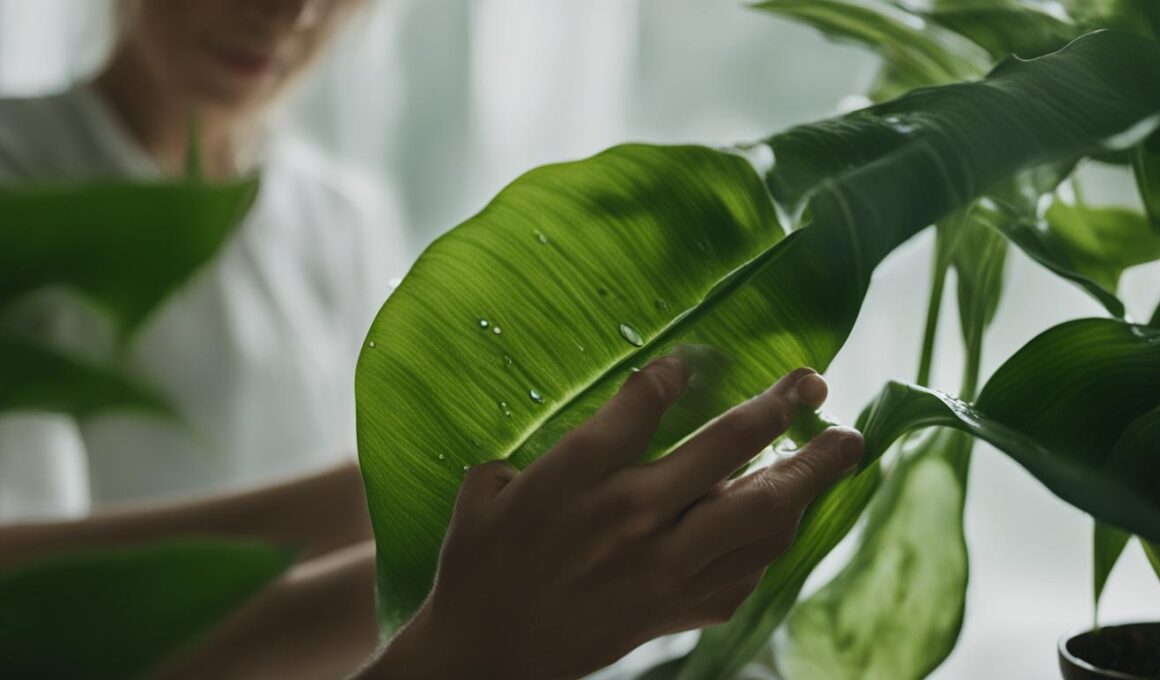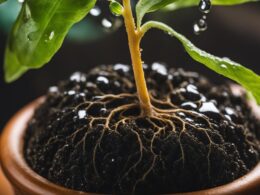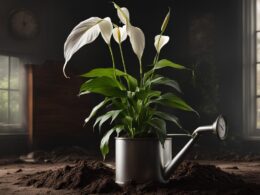Cleaning houseplant leaves is an essential task to maintain the health and appearance of your indoor plants. Leaf-shining products should be avoided as they can clog the plant’s stomata, which are crucial for respiration, photosynthesis, and transpiration. Instead, you can clean the leaves with a damp cloth, shower them with lukewarm water, use a mixture of soapy water, or try a solution of vinegar or lemon juice and water to remove residue buildup. Regularly cleaning your houseplant leaves helps them absorb sunlight more effectively and reduces the risk of pests and diseases.
Key Takeaways
- Cleaning houseplant leaves is important for maintaining their health and appearance.
- Avoid leaf-shining products as they can clog the plant’s stomata.
- Use a damp cloth, lukewarm water, soapy water, or a vinegar/lemon juice solution to clean the leaves.
- Regularly cleaning your houseplant leaves improves their ability to absorb sunlight.
- Clean leaves reduce the risk of pests and diseases.
Why Is Cleaning Your Plants Important?
Keeping your plants clean is not just about aesthetics – it’s essential for their overall health and vitality. Regular cleaning of your plant leaves has numerous benefits that contribute to their well-being. Here’s why cleaning your plants is so important:
- Improved sunlight absorption: Dust and debris can accumulate on the leaves over time, blocking precious sunlight. By cleaning the leaves, you ensure that they can absorb sunlight more efficiently, which is crucial for their growth and nourishment.
- Reduced risk of pests and diseases: Cleaning removes potential pests, such as spider mites or aphids, and disease-causing organisms that may have settled on the leaves. This reduces the risk of infestations and infections, keeping your plants healthier and more resistant to common plant ailments.
- Enhanced appearance: Clean plants not only look more visually pleasing, but they also demonstrate your care and attention to detail. Leaf surfaces free from dirt or residue will have a vibrant, healthy shine, creating a welcoming atmosphere in your home.
In summary, regular cleaning of your plants’ leaves is a simple yet effective way to ensure their optimum health and appearance. By promoting better sunlight absorption and reducing the risk of pests and disease, you can help your plants thrive and create a lush and vibrant indoor environment.
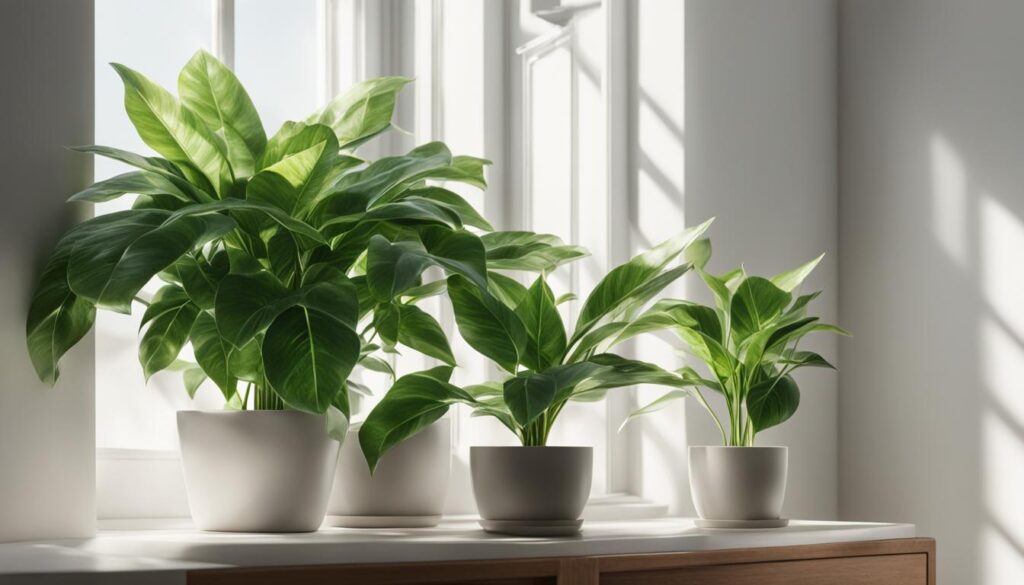
“Regular cleaning of your plants’ leaves is crucial for their overall health and well-being. By removing dust and debris, you help them absorb sunlight more effectively and reduce the risk of pests and diseases.” – Plant Enthusiast Magazine
How Often Should You Clean Your Plants?
Determining the frequency of cleaning your plants’ leaves is essential to maintain their health and vitality. While there is no one-size-fits-all answer, you can assess the cleaning needs of your indoor plants based on a few factors.
Environmental Conditions
Take into account the environment in which your plants are situated. If you live in a dusty area or have open windows, your plants are more likely to accumulate dust and debris on their leaves. In such cases, it is recommended to clean the leaves more frequently, perhaps once every two weeks or even weekly.
Visual Inspection
An easy way to determine when it’s time to clean your plants is through a visual inspection. Regularly check the leaves for any visible dust or debris. If you notice a layer of dust or feel dust particles when you rub the leaves gently, it’s time for a cleaning.
Touch Test
Another method to gauge the cleaning needs of your plants is through a touch test. When you water your plants, run your fingers over the leaves. If you feel a layer of dust or debris, it indicates that the leaves need cleaning.
By regularly assessing the cleanliness of your plants’ leaves based on environmental conditions, visual inspection, and touch tests, you can determine the optimal frequency of cleaning. Remember that each plant is different, and some may require more frequent cleaning than others. Cleaning your plants’ leaves as needed will help maintain their health and beauty, ensuring they thrive in their indoor environment.
How to Clean Plants – Different Methods
When it comes to cleaning your houseplant leaves, there are several effective methods you can choose from. Each method offers a safe and efficient way to remove dust and debris, promoting the overall health and vitality of your plants.
Gentle Wiping with Damp Cloth
One method is to use a damp cloth or sponge to gently wipe down the leaves. Start by supporting each leaf with one hand and wiping away from the stem to prevent damage. This method is particularly useful for removing light dust and dirt.
Showering with Lukewarm Water
Another option is to shower your plants using lukewarm water. This method ensures that water reaches the undersides of the leaves, removing any stubborn residue. Make sure the water is not too hot or too cold to avoid shocking the plants.
Using Natural Cleaning Solutions
For tougher residue, you can use a mixture of all-natural liquid soap and water. Simply mix a few drops of soap in a spray bottle filled with water and lightly spray the leaves. Alternatively, you can try a solution of vinegar or lemon juice and water. These natural ingredients help break down residue buildup effectively.
Remember, regardless of the cleaning method you choose, always support the leaves while cleaning to prevent any accidental damage. Regularly cleaning your plants’ leaves using these different methods will help keep them looking their best and promote their overall well-being.
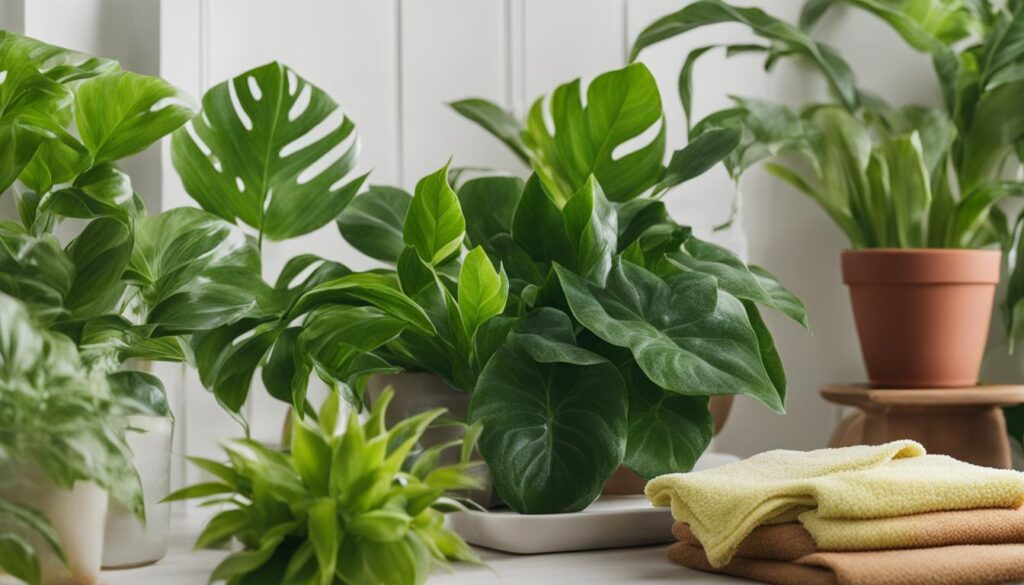
Other Tips for Cleaning Houseplant Leaves
When it comes to cleaning your houseplant leaves, there are a few additional tips and techniques that can help you maintain their health and appearance. Here are some expert recommendations to ensure your plants thrive:
- Remove dead or yellowing leaves: As you clean your plant’s leaves, take the opportunity to remove any dead or yellowing foliage. Gently remove loose leaves by hand or use clean shears or scissors to trim away browned leaf tips. This not only improves the overall appearance of the plant but also allows more nutrients to reach the healthy leaves.
- Use specific cleaning techniques: Different plants may require specific cleaning techniques. For example, plants with delicate leaves, such as ferns, may benefit from misting their leaves with water instead of using a cloth or sponge. Research your plant species to determine the best cleaning method.
- Avoid over-cleaning: While it’s important to keep your plant’s leaves clean, it’s equally important not to overdo it. Excessive cleaning can remove the natural protective wax on the leaves and disrupt the plant’s ability to retain moisture. Stick to a regular cleaning routine but avoid excessive wiping or washing.
By implementing these additional tips and techniques, you can ensure that your houseplants remain healthy and vibrant.
Is Misting Pothos Leaves Beneficial for Cleaning?
Misting Pothos leaves can benefit their overall cleaning routine. Pothos misting preferences involve providing a fine mist of water on their leaves, which helps remove dust, debris, and potential pests. This simple practice enhances the plant’s appearance, promotes better air circulation, and keeps the leaves looking fresh and vibrant.
Conclusion
Cleaning your houseplant leaves is an essential task that can greatly benefit the health and appearance of your indoor plants. By regularly removing dust and debris, you enable your plants to absorb sunlight more efficiently, promoting their growth and vitality. Additionally, cleaning helps reduce the risk of pests and diseases, ensuring that your plants remain in optimal condition.
When cleaning your plants, choose a method that suits their specific needs. Whether you prefer using a damp cloth, showering with lukewarm water, or utilizing natural cleaning solutions, make sure to support each leaf while cleaning to prevent any damage. Furthermore, take the opportunity to remove any dead or yellowing leaves, improving both the plant’s aesthetics and nutrient distribution.
Remember to also pay attention to the cleanliness of your plant pots. If you notice salt or mineral buildup, it’s important to clean the pots thoroughly using a diluted bleach solution. This helps maintain a healthy root environment for your plants.
By incorporating these final tips into your houseplant care routine, you can create a lush and vibrant indoor garden. Keep your plants clean, provide them with the optimal environment, and watch them thrive in your home.
Is the Cleaning Method for Overgrown Succulents Similar to Cleaning Houseplant Leaves?
When it comes to cleaning overgrown succulents efficiently, the method differs from cleaning houseplant leaves. Overgrown succulents may require trimming and repotting, while houseplant leaves can be wiped down with a damp cloth. Properly maintaining and cleaning these plants can ensure their long-term health and vibrancy.
FAQ
Why is cleaning your plants important?
Cleaning your plants is important because it helps them absorb sunlight more effectively, reduces the risk of pests and diseases, and improves their overall health and appearance.
How often should you clean your plants?
The frequency of cleaning your plants’ leaves depends on the amount of dust and debris in your home environment. As a general rule, you should check the leaves each time you water the plants and clean them whenever you notice visible dust or debris.
What are the different methods to clean houseplant leaves?
There are several effective methods to clean houseplant leaves. You can use a damp cloth or sponge, shower the plants with lukewarm water, use a mixture of all-natural liquid soap and water, or try a solution of vinegar or lemon juice and water to remove residue buildup.
Are there any additional tips for cleaning houseplant leaves?
Yes, when cleaning your houseplant leaves, it’s also a good opportunity to remove any dead or yellowing leaves. You can gently remove them by hand or use clean shears or scissors to trim away browned leaf tips. Additionally, clean the pots if they have salt or mineral buildup using a diluted bleach solution.
Why should you remove dead or yellowing leaves?
Removing dead or yellowing leaves improves the appearance of the plant and allows more nutrients to reach the healthy leaves, promoting overall plant health and vitality.





